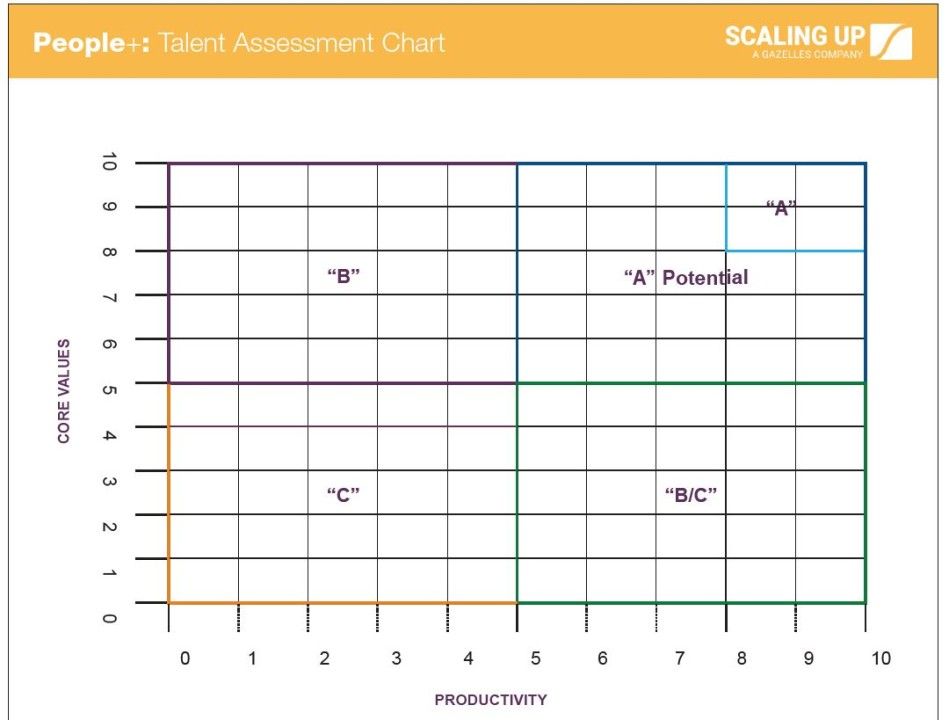In the fast-paced, ever-evolving business landscape, having the right talent in the right roles is paramount for sustained success. As a 20+ year CEO scaling up practitioner and certified scaling up coach, I have witnessed firsthand the transformative impact of robust talent assessment practices. Leveraging insights from the Aspire Talent Assessment Manager Guide, this article delves into the importance of talent assessment and provides a comprehensive framework to help leaders effectively evaluate and develop their teams.
Why Talent Assessment Matters
Talent assessment is more than a quarterly checkbox activity; it is a strategic tool that drives organizational growth, enhances employee engagement, and aligns talent with business goals. Regular and structured assessments help to:
- Recognize and retain top performers (A players).
- Identify and develop potential leaders (B players).
- Address performance issues proactively (B/C and C players).
- Foster a culture of continuous improvement and accountability.
The Talent Assessment Framework
The Aspire Talent Assessment Manager Guide outlines a systematic approach to evaluating employee performance and potential. This framework ensures that assessments are fair, comprehensive, and actionable.
Quarterly Assessments
Every quarter, managers conduct talent assessments for all employees who have been with the company for more than three months. These assessments focus on the last quarter's performance, ensuring that feedback is timely and relevant.
Key Outcomes of Talent Assessment
- Frequent and Timely Recognition: Acknowledging and rewarding A players fosters motivation and loyalty.
- Performance Improvement Plans: Addressing underperformance with structured improvement plans helps employees get back on track.
- Succession Planning: Identifying and preparing future leaders ensures organizational resilience.
- Clear Communication of Expectations: Regular assessments clarify performance expectations and align them with business goals.
- Talent Management Gaps: Assessments highlight areas needing attention, such as career planning and training, ensuring A employees are adequately supported.
Conducting the Assessment
Rating Process
Assessments should be conducted in management teams to provide a balanced perspective. Managers rate each employee based on their adherence to company core values and their productivity, both scored on a scale of 1-10. Disagreements are discussed to uncover potential blind spots and ensure ratings are well-rounded and justified.
Talent Assessment Chart
The results are plotted on a talent assessment grid, categorizing employees as A, A potential, B, B/C, or C players. This visual representation helps in understanding the distribution of talent within the organization and making informed decisions about development and succession planning.
Categories of Employees
- A Players: These are top performers who consistently exceed expectations. They embody the company's core values and deliver exceptional results. Recognizing and retaining A players is crucial for maintaining a high-performing team.
- B Players: These employees have a great attitude and potential but may need more experience or training. Investing in their development can help them transition to A players.
- B/C Players: Often referred to as "brilliant jerks," these employees are productive but do not align with the company's values or team dynamics. A clear plan, including a three-month timeline for improvement, should be in place to address their behavior.
- C Players: Employees who neither meet performance expectations nor fit the company culture. A plan should be made to end their employment if no improvement is seen after intervention.
Actionable Insights and Development Plans
Based on the assessment, managers should create 90-day action plans tailored to each employee's needs. These plans should be clear, simple, and impactful, focusing on development and improvement.
Recognition for A Players
Recognizing A players is vital for maintaining their motivation and loyalty. Consider personalized recognition strategies, such as:
- Handwritten notes with personal gifts.
- Special training opportunities.
- Public acknowledgment through LinkedIn reviews.
- Personalized gear or hobby-related rewards.
Ensuring Fair and Effective Assessments
To ensure the effectiveness of the talent assessment process:
- Maintain high expectations and consistency in ratings.
- Foster open communication among managers to discuss and resolve discrepancies.
- Use assessments to identify and address gaps in talent management, such as training needs and career development opportunities.
Conclusion
A robust talent assessment process is a cornerstone of successful organizations. By systematically evaluating and developing your team, you can ensure that you have the right talent in the right roles, driving your business toward sustained growth and success. As a scaling up practitioner and certified coach, I encourage business leaders to embrace talent assessments as a strategic tool that not only enhances individual performance but also strengthens the entire organization.
Send me a direct message or email me at herb@aspiregrowthadvisors.com if you would like to receive a copy of the Aspire Talent Assessment-Manager Guide. By implementing these best practices, you can create a culture of excellence, where every employee is aligned with the company's vision and equipped to contribute to its success. Embrace the power of talent assessment and unlock the full potential of your team today.

